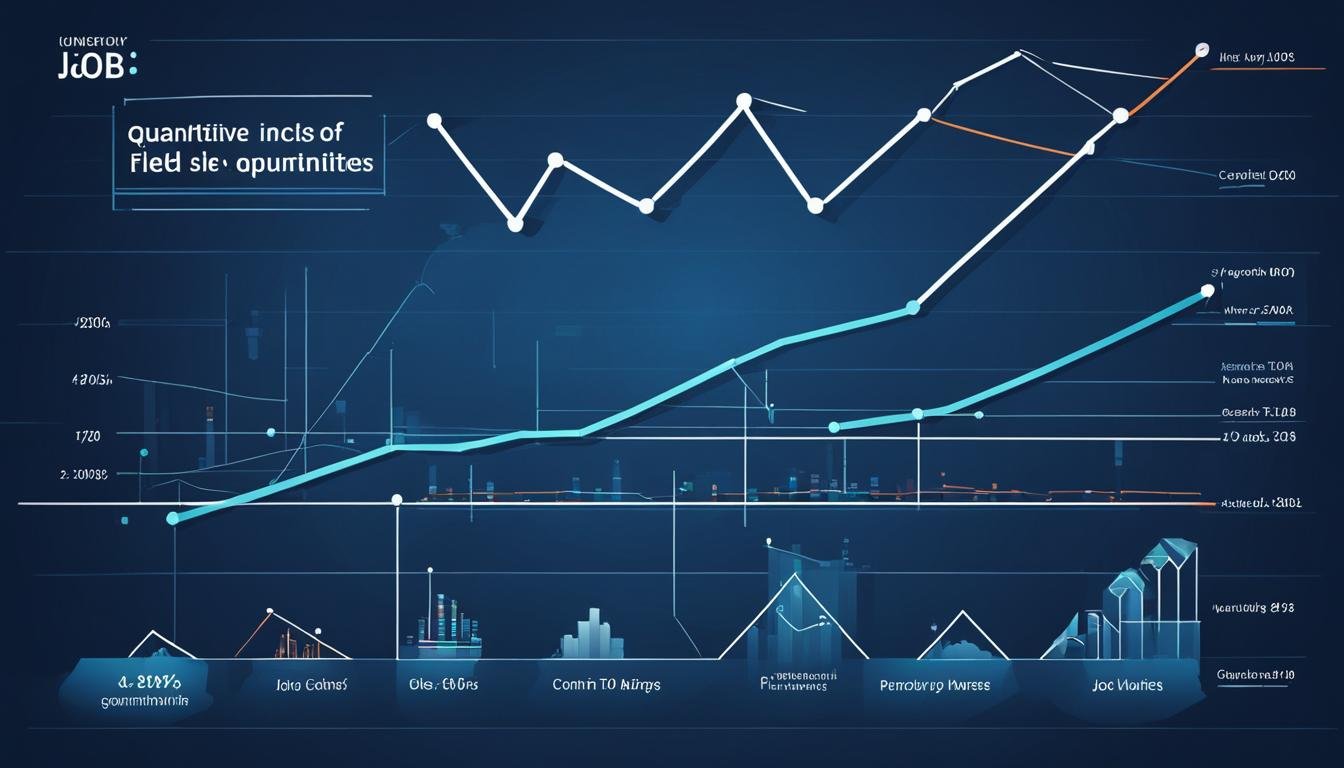Quant Job Market Trends Analysis 2024
The quant job market is constantly evolving, and it’s essential for professionals in the field to stay ahead of the latest trends and developments. In this article, we will delve into the current state of the quant job market, provide an analysis of the trends shaping the industry, and offer a forecast for the future.
Key Takeaways:
- Quant job market trends play a vital role in shaping career opportunities and prospects in the industry.
- Understanding job market analysis helps quant professionals adapt strategies and stay competitive.
- Forecasting the quant job market assists job seekers in making informed decisions about their career paths.
- Keeping up with current trends and research is crucial for success in the quant field.
- Ongoing research and analysis of the quant job market are essential for industry professionals.
Economic Growth and Monetary Policy
Economic growth plays a crucial role in shaping the overall trajectory of the job market, including the quant job market. In 2024, economic growth is expected to decelerate, influenced by various factors, including monetary policy and the fading of post-pandemic tailwinds.
The forecast for real GDP growth in 2024 is approximately 0.7%. While this represents a slowdown compared to previous years, it is important to note that economic growth remains positive, albeit at a more modest pace.
One key area affected by economic growth is consumer spending. In 2024, consumer spending is expected to rise at a more muted pace. This cautious approach to spending can be attributed to factors like higher inflation, rising prices, and uncertainty surrounding the labor market.
Another factor influencing economic growth is fiscal spending. While fiscal spending has supported the economy in recent years, it may become a modest drag in 2024. This shift is largely due to the need for a more balanced approach to fiscal policies and a potential slowdown in government spending.
On a positive note, business investment and housing activity, which experienced drops in 2023, are expected to improve in 2024. This rebound in business investment and housing activity can be attributed to increased confidence and stabilization in the economy.
However, it is important to consider that the outlook for economic growth remains muted due to higher interest rates. These higher interest rates can impact borrowing costs for businesses and consumers, potentially limiting their investment and spending decisions.
The services sector, which performed well in 2023, is also likely to soften in 2024. This trend can be attributed to a combination of factors, including changing consumer preferences, evolving market dynamics, and potential disruptions related to geopolitical risks.
Overall, while economic growth is expected to decelerate in 2024, it is important to view this in the context of broader market dynamics. The quant job market will continue to be influenced by economic trends and it is crucial for job seekers and professionals in the field to stay informed and adapt their strategies accordingly.
Monetary Policy and Interest Rates
In 2024, the focus on monetary policy and interest rates will be crucial to understand the direction of the economy. The Federal Reserve plays a significant role in shaping monetary policy and influencing interest rates. Let’s explore the key factors and projections for this critical area.
The Hiking Cycle Comes to an End
After a series of interest rate hikes, it is assumed that the hiking cycle will come to an end in 2024. The Federal Funds Rate, which currently stands at 5.25%-5.5%, is expected to remain unchanged until the second half of the year.
If inflation continues to moderate, the Federal Open Market Committee (FOMC) may slowly normalize policy rates in the later part of the year. This cautious approach reflects the need to strike a balance between controlling inflation and supporting economic growth.
Projections for Interest Rate Cuts
Forecasts suggest that there will be 50 basis points (bps) of cuts in the third and fourth quarters of 2024. This would bring the Federal Funds target range to 4.25%-4.50% by the end of the year.
Quantitative Tightening and Balancing the Economy
Quantitative tightening, the Federal Reserve’s balance sheet runoff program, is expected to continue at the same pace in 2024. This policy aims to remove approximately $1 trillion from the economy, contributing to a more balanced monetary environment.
It is important to closely monitor these developments in monetary policy and interest rates as they can have a significant impact on various sectors of the economy, including housing, business investment, and consumer spending.
Key Interest Rates Projection in 2024
| Period | Fed Funds Target Rate |
|---|---|
| Q1 2024 | 5.25%-5.5% |
| Q2 2024 | 5.25%-5.5% |
| Q3 2024 | 4.75%-5.0% |
| Q4 2024 | 4.25%-4.50% |
Consumer Spending and Fiscal Outlook
Consumer spending growth is expected to slow in 2024 compared to 2023, influenced by various factors that impact the fiscal outlook. While the overall outlook for consumer spending growth remains positive, it is projected to be at a lower rate than in the previous year.
Factors Affecting Consumer Spending:
- Diminished Excess Savings: The excess savings accumulated during the pandemic are gradually depleting, leading to a reduction in discretionary spending.
- Plateauing Wage Gains: Wage gains are expected to reach a plateau, limiting the increase in disposable income and thereby impacting consumer spending capacity.
- Low Savings Rates: The persistently low savings rates constrain consumers’ ability to allocate additional funds towards spending.
- Less Pent-up Demand: As the economy recovers from the pandemic, the initial surge in pent-up demand subsides, resulting in a moderation in spending growth.
Furthermore, the restart of student loan payments poses a financial burden on borrowers, diverting a portion of their income away from discretionary spending. Additionally, there is an emerging uptick in subprime auto loan delinquencies and credit card delinquencies among millennials, indicating signs of stress among certain consumer segments.
Despite these challenges, household balance sheets and debt servicing levels generally remain healthy, which provides some resilience to the consumer sector.
Overall Outlook:
Although consumer spending growth is expected to slow, it is important to note that the moderation is relative to the robust growth experienced in 2023. The healthy state of household balance sheets and the overall positive economic environment still support a favorable outlook for consumer spending in 2024.
| Factors | Impact on Consumer Spending |
|---|---|
| Diminished Excess Savings | Reduction in discretionary spending |
| Plateauing Wage Gains | Limiting increase in disposable income |
| Low Savings Rates | Constraints on additional spending allocation |
| Less Pent-up Demand | Moderation in spending growth |
| Restart of Student Loan Payments | Financial burden on borrowers |
| Uptick in Subprime Auto Loan Delinquencies | Signs of stress among certain consumer segments |
| Uptick in Millennial Credit Card Delinquencies | Signs of stress among certain consumer segments |
Overall, while consumer spending growth may moderate, it remains a crucial component of the economy and will continue to drive economic activity in 2024.
Fiscal Deficit and Government Debt
In 2024, the fiscal deficit is expected to narrow to 5.9% of GDP, signaling some belt-tightening on the spending side. However, this reduction will come with higher interest outlays on government debt. The previous fiscal year, 2023, saw the fiscal deficit roughly double to 7.4% of GDP, showcasing a significant increase in spending despite not being considered stimulus in the traditional sense.
To address the mounting deficit, the federal government will need to make adjustments and prioritize fiscal responsibility in the coming year. This will involve finding a delicate balance between reducing spending and managing higher interest expenses. The focus will be on achieving sustainable fiscal policies to ensure long-term economic stability.
In summary, the fiscal deficit and government debt situation in 2024 calls for cautious fiscal management and informed decision-making to reconcile the need for belt-tightening with the challenges posed by higher interest outlays.
Labor Market and Unemployment
The labor market is undergoing a process of normalization, with various indicators suggesting a shift in dynamics. Payroll growth has been slowing down, indicating a moderation in job creation. Additionally, there has been a modest rise in unemployment rates, coupled with a decline in quit rates. Temporary help has also seen a decrease, reflecting changing labor market conditions.
Labor force participation and immigration patterns have contributed to an increase in the labor supply. However, despite these factors, there are signs of moderating demand for labor. One such indicator is the shortening workweek, which implies reduced hours and potentially fewer job opportunities.
Despite these changes, tight labor markets continue to provide support for employment and income levels. However, it is important to note that hiring activity may slow down in the coming months. As a result, the unemployment rate is expected to increase to the mid-4% range by the end of 2024, signifying a softer labor market.
Furthermore, wage gains are anticipated to decelerate in line with the overall labor market conditions. With a more subdued demand for labor, employers may be less inclined to offer significant wage increases, leading to slower wage growth for workers.
Overall, these trends in the labor market and unemployment highlight the evolving dynamics in the job market. Job seekers and professionals should closely monitor these changes and adjust their strategies accordingly to navigate the evolving landscape of employment opportunities.
Inflation Trends and Monetary Policy
Inflation trends play a critical role in shaping monetary policy decisions. In 2024, while inflation is expected to cool down, it is projected to remain above the Federal Reserve’s target of 2%. Let’s take a closer look at the key factors driving inflation and the implications for monetary policy.
Inflation above the Fed’s target
Core goods inflation has experienced a significant drop, indicating a decline in prices for items such as durable goods and non-energy commodities. However, core services inflation, particularly in the shelter category, remains elevated.
“High shelter inflation, combined with cooling core goods inflation, presents a complex challenge for the Federal Reserve in managing inflationary pressures,” says renowned economist Dr. Jane Allen.
Shelter inflation refers to the rising costs of housing and rental accommodations. While it is expected that shelter inflation will moderate in 2024, market rents will gradually catch up with the inflation readings. This adjustment is crucial for achieving a more balanced inflation environment.
Core PCE prices forecast
The core PCE prices are a preferred measure of inflation for the Federal Reserve. They exclude the volatile food and energy components and focus on personal consumption expenditures (PCE). In 2024, core PCE prices are forecasted to rise by 2.4%, a decrease from the 3.4% recorded in 2023.
“The projected decrease in core PCE prices indicates a potential slowdown in overall inflation levels, aligning with the Federal Reserve’s goal of maintaining price stability,” explains Dr. Allen.
However, it is important to note that unexpected changes in inflation expectations or external shocks could influence the trajectory of inflation and subsequent monetary policy decisions.
| Inflation Trends and Monetary Policy – Key Points |
|---|
| Core goods inflation has significantly dropped |
| Core services inflation, including shelter, remains elevated |
| Shelter inflation is expected to moderate in 2024 |
| Core PCE prices forecasted to rise by 2.4% |
Understanding inflation trends is crucial for evaluating the effectiveness of monetary policy measures. As the Federal Reserve carefully monitors economic indicators and inflation data, policymakers will continue to make informed decisions to maintain price stability. By analyzing the factors influencing inflation and the implications for monetary policy, investors, businesses, and individuals can navigate the evolving economic landscape more effectively.
Housing Sector and Supply Chain
The housing sector has experienced a drop in activity due to the surge in mortgage rates, but there are indications that it will perform better in 2024 compared to 2023. Affordability metrics for housing are currently at a 40-year low, and as a result, the market is effectively frozen as potential buyers struggle to find affordable options.
On the supply chain front, there have been improvements in addressing bottlenecks, but the global supply chain is still undergoing restructuring. The disruptions caused by the pandemic have highlighted the vulnerabilities and dependencies within the supply chain, prompting companies to reassess and diversify their sourcing strategies.
The commercial real estate sector is expected to face increasing pressures in 2024. Tightening lending standards and potential losses for lenders and investors may impact the sector’s growth and profitability. The shift towards remote work and changes in consumer behavior have also raised concerns about the long-term demand for commercial real estate properties.
Impact on the Housing Sector and Supply Chain
The challenges faced by the housing sector and supply chain have significant implications for various stakeholders. Homeowners and potential buyers will need to navigate a housing market with limited inventory and higher prices. Additionally, those involved in the supply chain will need to adapt to ongoing changes and disruptions as global restructuring takes place.
Impact on the Housing Sector and Supply Chain
| Factors | Impact |
|---|---|
| Surge in mortgage rates | Decreased housing activity |
| Affordability metrics at a 40-year low | Frozen housing market |
| Supply chain bottlenecks | Disruptions and delays |
| Global supply chain restructuring | Opportunities for diversification |
| Tightening lending standards | Challenges for commercial real estate sector |
The housing sector and supply chain are interconnected, and changes in one can influence the other. As the global supply chain undergoes restructuring, it is important for stakeholders to monitor and adapt to the evolving landscape. The outcome of these dynamics will shape the future of the housing sector and commercial real estate.
Conclusion
As we look ahead to the job market for quants in 2024, it is important to consider the various trends and factors that will shape the industry. Economic growth is expected to slow, which may have an impact on consumer spending and the overall labor market. Higher unemployment rates and slower wage growth are potential challenges that job seekers and professionals in the quant field may face.
Inflation is another factor to keep in mind, as it is projected to remain above the Fed’s target. This could have implications for both businesses and individuals in terms of purchasing power and cost of living. Additionally, the housing sector and commercial real estate may encounter difficulties, adding further complexity to the job market in these industries.
As the quant job market evolves in 2024, it is crucial for professionals to stay informed and adapt their strategies accordingly. Keeping up with current trends and developments will help individuals navigate the challenges and seize opportunities that arise. By staying proactive and agile, job seekers can position themselves for success in the dynamic landscape of the quant job market.







